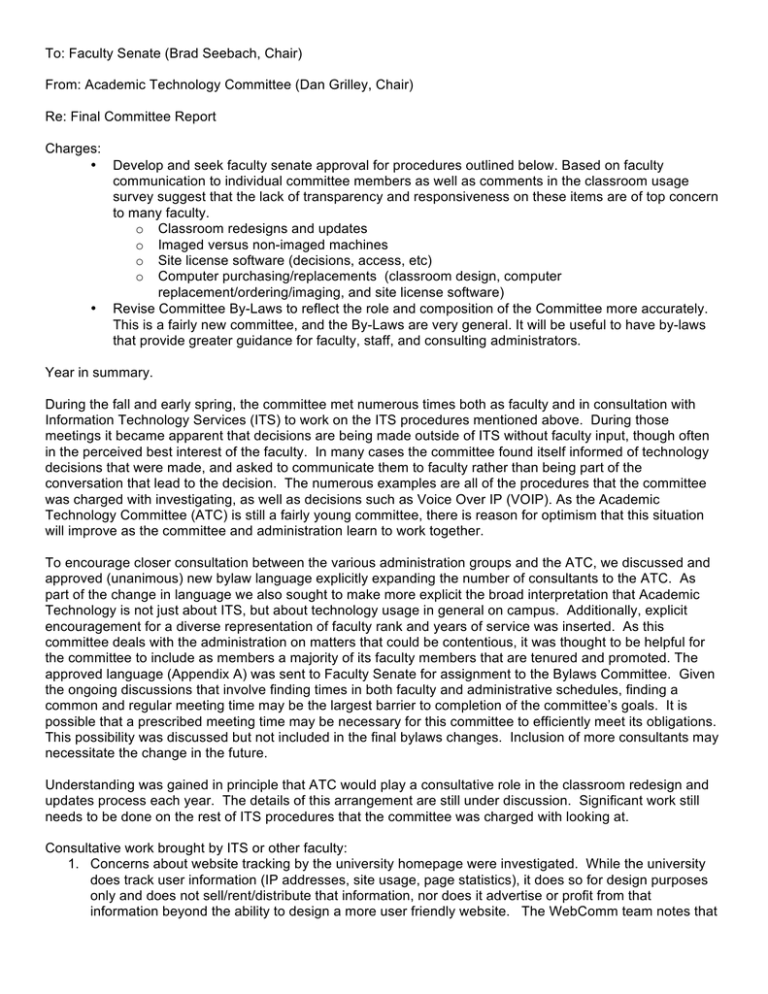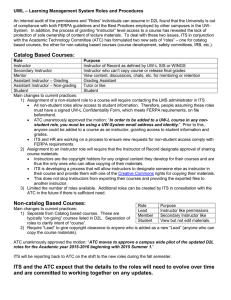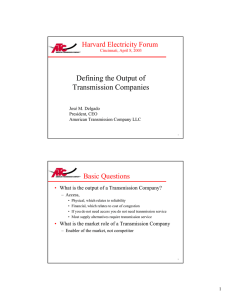To: Faculty Senate (Brad Seebach, Chair) Re: Final Committee Report
advertisement

To: Faculty Senate (Brad Seebach, Chair) From: Academic Technology Committee (Dan Grilley, Chair) Re: Final Committee Report Charges: • Develop and seek faculty senate approval for procedures outlined below. Based on faculty communication to individual committee members as well as comments in the classroom usage survey suggest that the lack of transparency and responsiveness on these items are of top concern to many faculty. o Classroom redesigns and updates o Imaged versus non-imaged machines o Site license software (decisions, access, etc) o Computer purchasing/replacements (classroom design, computer replacement/ordering/imaging, and site license software) • Revise Committee By-Laws to reflect the role and composition of the Committee more accurately. This is a fairly new committee, and the By-Laws are very general. It will be useful to have by-laws that provide greater guidance for faculty, staff, and consulting administrators. Year in summary. During the fall and early spring, the committee met numerous times both as faculty and in consultation with Information Technology Services (ITS) to work on the ITS procedures mentioned above. During those meetings it became apparent that decisions are being made outside of ITS without faculty input, though often in the perceived best interest of the faculty. In many cases the committee found itself informed of technology decisions that were made, and asked to communicate them to faculty rather than being part of the conversation that lead to the decision. The numerous examples are all of the procedures that the committee was charged with investigating, as well as decisions such as Voice Over IP (VOIP). As the Academic Technology Committee (ATC) is still a fairly young committee, there is reason for optimism that this situation will improve as the committee and administration learn to work together. To encourage closer consultation between the various administration groups and the ATC, we discussed and approved (unanimous) new bylaw language explicitly expanding the number of consultants to the ATC. As part of the change in language we also sought to make more explicit the broad interpretation that Academic Technology is not just about ITS, but about technology usage in general on campus. Additionally, explicit encouragement for a diverse representation of faculty rank and years of service was inserted. As this committee deals with the administration on matters that could be contentious, it was thought to be helpful for the committee to include as members a majority of its faculty members that are tenured and promoted. The approved language (Appendix A) was sent to Faculty Senate for assignment to the Bylaws Committee. Given the ongoing discussions that involve finding times in both faculty and administrative schedules, finding a common and regular meeting time may be the largest barrier to completion of the committee’s goals. It is possible that a prescribed meeting time may be necessary for this committee to efficiently meet its obligations. This possibility was discussed but not included in the final bylaws changes. Inclusion of more consultants may necessitate the change in the future. Understanding was gained in principle that ATC would play a consultative role in the classroom redesign and updates process each year. The details of this arrangement are still under discussion. Significant work still needs to be done on the rest of ITS procedures that the committee was charged with looking at. Consultative work brought by ITS or other faculty: 1. Concerns about website tracking by the university homepage were investigated. While the university does track user information (IP addresses, site usage, page statistics), it does so for design purposes only and does not sell/rent/distribute that information, nor does it advertise or profit from that information beyond the ability to design a more user friendly website. The WebComm team notes that it does not have control of the tracking cookies from sites visited by individual users prior to arriving at the uwlax.edu homepage. 2. Concerns that students can email to a course specific email mailing list without the instructor being notified. The ATC made two recommendations – 1) that instructors be included as a member of the email mailing list for each course, and 2) that students not be given access to the D2L classlist function for sending emails to the entire course. 3. Student Senate approved a resolution to make duplex printing the default for the printers across campus. This resolution was denied (unanimous) by the ATC. In its place, a limited pilot project was initiated for the library computers. This pilot project will be reported on during the fall semester and changes or adoption will be considered then. 4. ITS initiated a consultation on the roles and permissions used on D2L with a goal of bringing D2L into compliance with the relevant regulations and best practices. As part of this consultation a pilot of new permissions was approved for the start of the 2015-2016 academic year, beginning with the 2015 summer 1 session. ITS and ATC will consider the impact of those changes and updates to the policy during the 2015-2016 academic year. This process is expected to be on-going in nature as the needs of the campus and industry best practices change. The changes were summarized and sent to Faculty Senate for approval. The adopted changes are summarized in Appendix B. Future Work: 1. ATC, in conjunction with ITS, Admin and Finance, Facilities and Planning, and Academic Affairs, should complete its work on including ATC in the process of updating and renovating campus classrooms. ATC has offered to play the role of helping to screen potential updates to classroom. It has also offered to gather faculty/department input into changes being made to non-departmental classrooms. In this regard, ATC could function like other oversight committees (UCC) in approving changes that affect how instruction occurs on campus. Preliminary agreement on the main principles underlying this change were agreed to this year, but many details need to be worked out. 2. Significant work needs to be done to provide input into the other procedures being discussed – computer purchases, site-licensing, and computer imaging. Based on preliminary discussions, this work will include consultation with administrative units beyond ITS. 3. Follow up on pilot projects initiated during the 2014-2015 academic year. a. duplex printing – this is an ongoing push by student senate as a means to reduce the paper waste generated on campus. b. D2L roles – expected report by ITS is during the fall semester. 4. Develop, in consultation with ITS, a procedure for discontinuing support for specific campus technologies (for example, DVD players when they become obsolete, the campus standard computers, etc). There is currently no formal procedure for this and each case is dealt with as needed. A more formalized and regular discussion between ITS and ATC of what ITS is projected to support versus term obsolete would help provide transparency surrounding technology on campus. 5. Recruit department liaisons to serve as point people for both soliciting comments on ATC discussions and disseminating information on changes to campus technology. This would serve to broaden the input the committee receives. This would be important as ATC moves to provide input into technology updates to individual classrooms. 6. Continue to advocate for ATC as a committee for formulating policies and procedures for campus technology usage. Respectfully submitted, Dan Grilley Chair 2013-2015 Appendix A) Changes to ATC Bylaws OLD: Duties and responsibilities of the committee shall include: 1. Studying and reporting to the Senate on issues related to information technology as it affects instruction, research and service. 2. Serving as a liaison between faculty and the office of Information Technology (ITS) to ensure that technology is responsive to faculty needs for instruction, research and service. 3. Reviewing and making recommendations to the Senate regarding ITS policies and procedures as they relate to faculty interests. Membership of the committee will consist of nine faculty members. The faculty membership shall include at least one member from each of the following: the College of Business Administration, the College of Liberal Studies, and the College of Science and Health. The Assistant Vice Chancellor for Information Technology Services shall serve as an administrative consultant for the committee. The committee shall elect its chairperson. NEW: Duties and responsibilities of the committee shall include: 1. Study and report to the Senate on technology-related issues as they affect instruction, research, and service. 2. Serving as a liaison between faculty and the divisions of Administration & Finance and Academic Affairs to ensure that technology is responsive to faculty needs for instruction, research, and service. 3. Reviewing and making recommendations to the Senate regarding administrative policies and procedures as they relate to technology in instruction, research, and service. 4. Informing department ATC liaisons, in writing, of policy and procedure proposals being considered thus providing adequate opportunity for departments/programs to be heard prior to committee and senate action on such proposals. Membership of the committee will consist of nine faculty members of diverse rank and years of service. The faculty membership shall include at least one member from each of the following: the College of Business Administration, the College of Liberal Studies, the College of Science and Health, and the School of Education. The Assistant Vice Chancellors or their designees from Information Technology Services, Financial Services, and Facilities Planning and Management shall serve as administrative consultants to the committee. The Provost/Vice Chancellor and the Academic Deans shall also provide administrative consultants to the committee. The committee shall elect its chairperson and its recorder. Appendix B) UWL – Learning Management System Roles and Procedures An internal audit of the permissions and “Roles” individuals can assume in D2L found that the University is out of compliance with both FERPA guidelines and the Best Practices employed by other campuses in the UWSystem. In addition, the process of granting “Instructor” level access to a course has revealed the lack of protection of sole ownership of content of lecture materials. To deal with these two issues, ITS in conjunction with the Academic Technology Committee (ATC) has formulated two new sets of “roles” – one for catalog based courses, the other for non-catalog based courses (course development, safety committees, IRB, etc.). Catalog Based Courses: Role Purpose Instructor Instructor of Record as defined by UW-L SIS or WINGS Secondary Instructor Instructor who can’t copy course or release final grades Mentor View content, discussions, chats, etc. for mentoring or retention Assistant Instructor – Grading Grading Assistant Assistant Instructor – Non-grading Tutor or like Student Student Main changes to current practices: 1) Assignment of a non-student role to a course will require contacting the LMS administrator in ITS • All non-student roles allow access to student information. Therefore, people assuming these roles must have a signed UW-L Confidentiality Form, which meets FERPA requirements, on file beforehand. • ATC unanimously approved the motion: “In order to be added to a UW-L course in any nonstudent role, you must be using a UW-System email address and identity.” Prior to this, anyone could be added to a course as an instructor, granting access to student information and grades. • ITS and HR are working on a process to ensure new requests for non-student access comply with FERPA requirements. 2) Assignment to an Instructor role will require that the Instructor of Record designate approval of sharing course materials. • Instructors are the copyright holders for any original content they develop for their courses and are thus the only ones who can allow copying of their materials. • ITS is developing a process that will allow instructors to designate someone else as instructor in their course and provide them with one of the Creative Commons rights for copying their materials. • This does not stop Instructors from exporting their courses and providing the exported files to another instructor. 3) Limited the number of roles available. Additional roles can be created by ITS in consultation with the ATC in the future if there is sufficient need. Non-catalog Based Courses: Role Purpose Main changes to current practices: Lead Instructor like permissions 1) Separate from Catalog based courses. These are Member Secondary Instructor like typically “on-going” courses listed in D2L. Separation of Student View but not edit materials. roles to clarify intent of “course”. 2) Require “Lead” to give copyright clearance to anyone who is added as a new “Lead” (anyone who can copy the course materials). ATC unanimously approved the motion: “ATC moves to approve a campus wide pilot of the updated D2L roles for the Academic year 2015-2016 beginning with 2015 Summer 1.” ITS will be reporting back to ATC on the shift to the new roles during the fall semester. ITS and the ATC expect that the details of the roles will need to evolve over time and are committed to working together on any updates.


